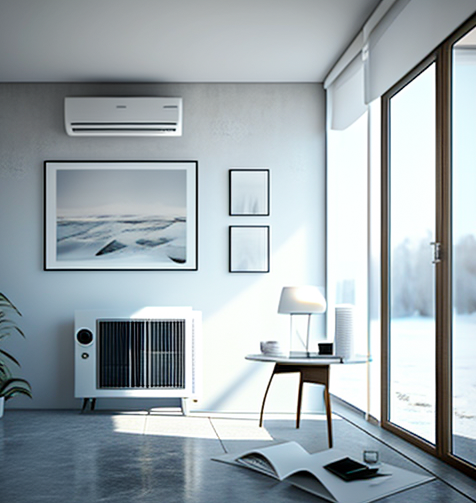Rooftop Air Conditioner Vs A Side-Yard Air Conditioner
Climate control is an important factor to consider when building or remodeling a home. Air conditioning systems are essential in many parts of the world, and choosing the right system is critical for both performance and budgeting.
When it comes to air conditioners, there are two primary options available: rooftop air conditioners and side-yard air conditioners. This article will compare these two types of air conditioning systems, discussing their advantages and disadvantages in detail so that homeowners can make an informed decision about which type best fits their needs.
The first step in comparing rooftop air conditioners versus side-yard units is to look at how they fit into different scenarios. Rooftop units offer convenience for properties with limited space since they take up less physical space than ground level ACs.

Definition Of Rooftop And Side-Yard Air Conditioners
Air conditioners are an important part of a home’s cooling system. There are two main types of air conditioners, rooftop and side-yard. A rooftop air conditioner is installed on the roof of a house or building, typically near the highest point; this type is ideal for homes with limited outdoor space due to its compact size.
The unit needs regular maintenance to ensure that it operates efficiently and safely. Side-yard air conditioners are larger units designed for installation outside the walls of a property. They require more space than rooftop models but can also be used in areas where there is minimal room available outdoors.
These models usually come with greater cooling capacity as well as higher energy efficiency ratings compared to their counterparts on the roof. Both systems must be regularly maintained to keep them running smoothly and at optimal efficiency level. Additionally, both need to comply with local codes regarding noise levels, emission standards and other regulations set by authorities such as city councils or state governments.
Advantages And Disadvantages Of Rooftop Air Conditioners
Rooftop air conditioners are commonly used in many residential and commercial buildings due to their ease of installation, durability, energy efficiency, and cost effectiveness. On the other hand, side-yard air conditioners require more space for installation as they need to be placed on a flat or slightly sloped surface.
Additionally, they tend to create noise pollution which can reduce comfort levels in the surrounding environment.
When it comes to advantages, rooftop air conditioners offer better performance than side-yard systems since they are located away from potential obstructions such as trees or other buildings. Their higher elevation also provides improved hot air evacuation during summer months and prevents damage caused by flooding during heavy rains.
Furthermore, these units are less likely to suffer from dirt buildup as compared with ground mounted models. In terms of energy savings, rooftop air conditioning units have a much lower operating cost compared to side-yard ACs due to their superior insulation capabilities.
Lastly, maintenance costs for rooftop systems are typically cheaper than those associated with ground level counterparts because repairs can be performed from above without having to access inside the building itself.
It should be noted that there are some drawbacks associated with rooftop air conditioners as well including increased risk of fire hazards due to close proximity of nearby combustible materials and additional strain on roofing structures caused by unit weight..
Advantages And Disadvantages Of Side-Yard Air Conditioners
Side-yard air conditioners can offer numerous advantages when compared to rooftop units. These systems are typically easier and less expensive to install, since they do not require access to the roof of a building or other large structure.
Side-yard air conditioners also tend to be more efficient than rooftop models due to their proximity to the ground, which allows for better heat dissipation in outdoor spaces. Additionally, side-yard units provide greater flexibility in terms of where they can be installed, as these systems can easily fit into most landscaping designs without requiring extensive modification.
Their portability is another benefit that makes them ideal for temporary or seasonal applications.
On the downside, side-yard air conditioners may be more susceptible to damage from wind and inclement weather conditions due to their lower placement on the property. They may also need additional insulation if installed in particularly cold climates.
Furthermore, there will likely be an increased noise level with any system positioned closer to living areas on a property. In general, careful consideration should be given before deciding between a rooftop unit or one placed at ground level.
Cost Comparison
When it comes to cost comparison, rooftop air conditioners and side-yard air conditioners have some distinct financial implications. Rooftop units can be more expensive than their side-yard counterparts due to the installation process. The materials used in a rooftop unit are generally of higher quality than those used for a side-yard model, driving up the cost of purchase and labor costs associated with installation. This is mainly because of the additional reinforcement that needs to be done when installing a rooftop AC unit on an existing structure.
In addition, ongoing maintenance costs may also be greater for rooftop units due to the difficulty in accessing them. On average, routine service fees will likely be higher compared to ground level systems as climbing onto roofs presents inherent safety risks and longer repair times.
Depending on geographic location, energy efficiency ratings could make one system more advantageous over another financially; however, this should always take into account other factors such as performance output and reliability.
Installation Processes
Installing a rooftop air conditioner is more complex than installing one in the side yard. Installing a rooftop unit requires an installer to first ensure that the roof can support its weight, as well as any wind or snow loads that may occur. They must also check for obstructions on the roof and have access to power outlets and ducts.
Once these steps are completed, they will then need to mount the outdoor unit, install drain lines for condensation, connect refrigerant lines between indoor and outdoor units, wire electrical components correctly and test all systems before use.
The installation of a side-yard air conditioner is much simpler; it does not require additional structural work such as checking for load ratings or mounting onto rooftops. Generally speaking, this type of installation involves positioning the outside unit and connecting it with pipes and wiring to the inside unit. The system should be tested after assembly and adjusted if necessary before being put into use.
Maintenance Requirements
The installation process is a crucial step in determining the efficacy and lifespan of an air conditioner. Having identified the two main types of AC units, rooftop and side-yard models, it is also important to consider how each type affects maintenance requirements.
Rooftop units are generally easier to access than their side-yard counterparts due to their raised placement. This allows for more frequent inspections and repairs as needed without the need for special tools or equipment.
Additionally, rooftop units often require less regular maintenance since they are typically located away from elements that cause damage such as dirt, debris and falling branches. However, when inspecting these systems, consideration should be taken regarding potential hazards associated with working at height on steep rooftops.
Side-yard air conditioners may require more frequent cleaning due to their close proximity to surface level obstructions like leaves and other debris but can still provide reliable service if sufficiently maintained. Special care must be taken to ensure any connections between components remain secure during periods of high wind and rain which could otherwise compromise the system’s performance.
Furthermore, while most side-yard units have easy access points for inspection, some older models may necessitate additional steps depending upon design features such as protective covers or panels over internal components.
Thus it is essential to weigh both factors carefully before selecting either type of unit; not only considering its initial cost but also its related maintenance obligations which ultimately determine its long term efficiency and effectiveness.

Environmental Impact
The environmental impact of rooftop air conditioners and side-yard air conditioners must be considered before making a decision. Rooftop units are generally more efficient than those placed on the ground, as they can take advantage of higher outdoor temperatures.
Additionally, these systems typically use less energy by utilizing natural ventilation to reduce cooling loads. On the other hand, side-yard air conditioners require more energy consumption due to their placement close to the building itself. Furthermore, this type of system produces noise pollution since it is located in closer proximity to people within the home or office space.
In terms of installation costs, both types of systems have similar expenses associated with them; however, if a professional installer is required for either option then there could be added cost considerations depending on the complexity of the installation and any additional materials needed.
Ultimately, each case needs to be evaluated individually when deciding which air conditioning unit will provide greater efficiency and lower operating costs over time.







